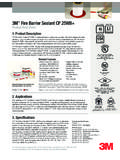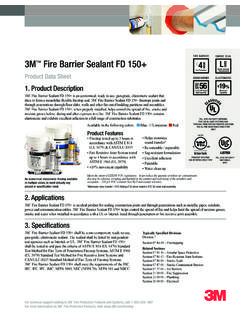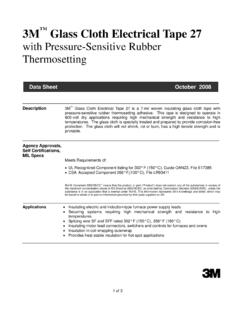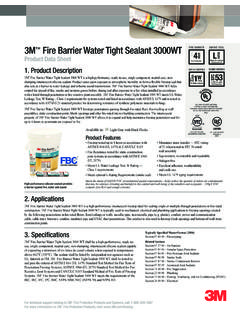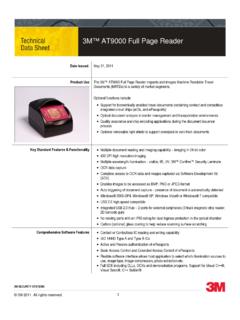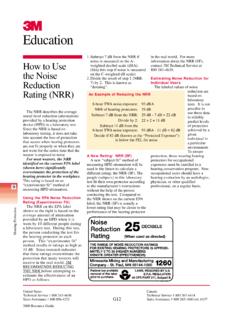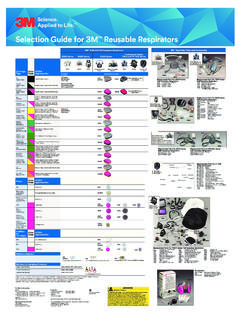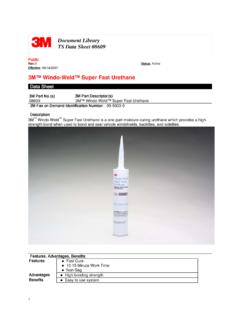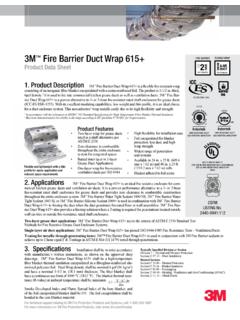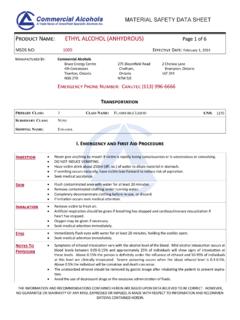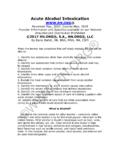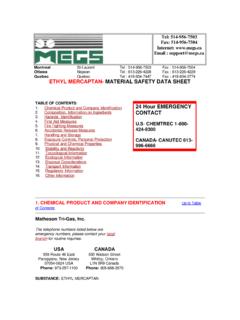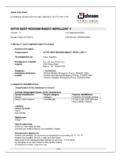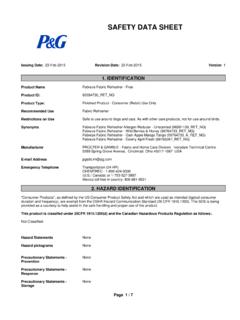Transcription of Considerations for Use
1 Meets CDC, FDA and AORN criteriafor surgical scrub Avagard (Chlorhexidine Gluconate 1% Solution and ethyl Alcohol 61% w/w) Surgical and Healthcare Personnel Hand Antiseptic with Moisturizers Considerations for Use2provenskin conditioningpersistenceTable of Contents The Role of Surgical Hand Scrub and Hand Antisepsis in Preventing Infection ..3 The Effects of Traditional Scrub Agents on Skin Integrity ..4 Recognized Active Ingredients Provide Immediate, Persistent and Cumulative Activity ..5 6 Fast, Effective, Persistent Activity ..7 Meets FDA NDA Requirements ..8 Surgical Hand Scrub , Persistent Activity as a Healthcare Personnel Handwash ..10 Skin Condition Helps Maintain Skin Integrity.
2 11 Skin Condition Studies ..12 14 Proven Safety ..15 Latex Glove Compatibility ..15 CHG Compatibility ..15 Instructions for use of 3M Avagard ..16 (Chlorhexidine Gluconate 1% Solution and ethyl Alcohol 61% w/w) Surgical and Healthcare Personnel Hand Antiseptic with Moisturizers3M Avagard Products .. Role of Surgical Hand Scrub and Hand Antisepsis in Preventing InfectionSurgical hand antisepsis plays a significant role in preventing healthcare associated infections and surgical site infections and the subsequent morbidity, mortality, and cost associated with them. Handwashing is known to be the single most important action in preventing hands of healthcare providers carry microorganisms identified as sources of microbial ,2 For healthcare providers, the skin flora isolated from the hands can include coagulase-negative staphylococci (CNS), micrococci, Staphylococcus aureus, -hemolytic streptococci, yeasts, fungi, lipophilic corynebacteria, large-colony diphtheroids, and other gram-positive and gram-negative Some of these same organisms, notably S.
3 Aureus and CNS, are also the leading causes of surgical site help combat this problem, hand antisepsis is performed to remove or destroy transient microorganisms and for surgical scrubbing, to remove or destroy transient microorganisms and reduce resident Hand antisepsis and surgical scrub agents have been refined over the years, offering increasingly effective and broader spectrum microbial kill, first with povidone-iodine and hexachlorophene, and later, chlorhexidine Cost of InfectionsHealthcare Associated Infections Approximately 2 million patients per year acquire nosocomial infections12 Estimated cost of these infections is between $ and $10 billion12,13 60,000 to 80,000 patients die each year due to nosocomial infection12 Surgical Site Infections Approximately 500,000 of all nosocomial infections are SSIs14 On average, SSIs result in an additional days in the hospital15 The resulting cost is an additional $3,152 per infected patient15 Approximately 10.
4 000 deaths occur annually due to SSIs13 Incidence of Pathogens Isolated in Surgical Site Infections15 Staphylococcus aureus* 20%Coagulase-negative staphylococci* 14%Enterococcus faecalis 12%Escherichia coli 8%Pseudomonas aeruginosa 8%*Common skin flora found on the Effects of Traditional Scrub Agents on Skin Integrity Unfortunately, the effects of frequent scrubbing and handwashing can also damage the skin s 3,5 10 The primary function of the skin s stratum corneum is to provide a barrier to moisture, water-soluble chemicals, and Healthy skin needs to be soft, pliable, and hydrated to maintain its barrier Fatty acids found in the stratum corneum help the skin maintain its barrier by preventing Additionally, these fatty acids have fungicidal and bactericidal activity important to modulating the balance of flora on the Yet, many of today s antiseptic scrub agents, although highly effective against a broad spectrum of infectious organisms, compromise the integrity of the skin s natural barrier by dehydrating and defatting the skin.
5 Resulting in a loss of moisture, pliability, and 3,6,10,16 21 The consequence of damaged skin on the hands of health care providers is that damaged skin can harbor large numbers of microorganisms, shed greater numbers of these microorganisms because of increased desquamation of dry skin, and become a deterrent to good handwashing 3,6,8,10 Damaged hands are very prevalent among health care professionals because of frequent handwashing with harsh ,19, 2 0 Based on surveys of operating room nurses at the Association of periOperative Registered Nurses (AORN) 1996 and 1997 conferences, approximately 75% of nurses reported having problems with their hands including: dry, scaly, cracked skin; red blotchy skin.
6 Or The frequency of handwashing/scrubbing and the soap/antimicrobial agent used were among the most common reasons cited for damaged address this problem, the focus of hand antisepsis is shifting to incorporate maintaining the skin s health and integrity as a preventative measure against 4 AORN, in their most recent guidelines, call for the following criteria when selecting an antimicrobial surgical hand scrub:The surgical hand scrub agent should: contain a nonirritating antimicrobial preparation significantly reduce microorganisms on intact skin be broad spectrum be fast acting have a persistent effect1 Because many surgical scrub and hand antisepsis agents increase the damage to hands as well as the risk for contamination, leaders in infection control now call for increased emphasis on maintaining the skin s natural barrier as an adjunct to antimicrobial activity in preventing ,105 Recognized Active Ingredients Provide Immediate, Persistent and Cumulative Activity 3M Avagard (Chlorhexidine Gluconate 1% Solution and ethyl Alcohol 61%, w/w)
7 Surgical and Healthcare Personnel Hand Antiseptic with Moisturizers contains two proven active ingredients to provide immediate, persistent and cumulative activity needed in a surgical hand antiseptic: alcohol for fast immediate broad spectrum kill and chlorhexidine gluconate for persistent and cumulative activity (see chart on following page).AlcoholAlcohols are rapidly germicidal when applied to the skin, but according to the FDA, CDC, and AORN they have no appreciable persistent or cumulative activity. In appropriate concentrations, from 60 to 95%, alcohols provide the most rapid and greatest reduction in microbal counts on the GluconateChlorhexidine gluconate s activity is slower than that of alcohols while still providing broad-spectrum activity.
8 Two of the most important attributes of CHG are its persistent activity and its cumulative activity. This cumulative activity is not achieved with one application but builds with repeated daily :Active ingredient: Per the FDA According to 21 CFR (b)(7), an active ingredient is any component of a drug product intended to furnish pharmacological activity or other direct effect in the diagnosis, cure, mitigation, treatment, or prevention of ingredient: Per the FDA According to 21 CFR (b)(8), an inactive ingredient is any component of a drug product other than the active activity is a product s ability to provide bacterial kill at 1 minute after the application (criteria established by the FDA).
9 Persistent activity is a product s ability to maintain low bacterial counts on the skin after a single application for an extended length of time, generally 6 hours (criteria established by the FDA).Cumulative activity is a product s ability to lower the overall resident bacterial count on the hands when the product is applied repeatedly (11 applications over 5 days criteria established by the FDA). Per the FDA, preservative (inactive) levels of ingredients can not contribute to the claimed effects of the product in which they are included.** FDA Tentative Final Monograph (TFM) for Health Care Antiseptic Drug Products, Proposed Rule Federal Register, Vol.
10 43, No. 4 (Friday, January 6, 1978) Code of Federal Regulations 21 CFR Part GroupGram-positive bacteriaGram-negative bacteriaBacteriaFungiVirusesSpeed of ActionCommentsAlcohols+++++++++++++++Fas tOptimum concentration 60% 95%; no persistent activityChlorhexidine (2% and 4% aqueous)++++++++++IntermediatePersistent activity; rare allergic reactionsIodine compounds++++++++++++++IntermediateCause s skin burns; usually too irritating for hand hygieneIodophors+++++++++++IntermediateL ess irritating than iodine; acceptance variesPhenol derivatives+++++++IntermediateActivity neutralized by nonionic surfactantsTriclosan++++++ +++IntermediateAcceptability on hands variesQuaternary ammonium compounds+++ +SlowUsed only in combination with alcohols ; ecological concernsNote: +++ = excellent; ++ = good, but does not include the entire bacterial spectrum; + = fair; = no activity or not sufficient.
